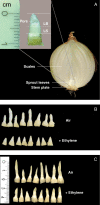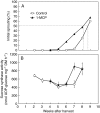Exogenous ethylene inhibits sprout growth in onion bulbs
- PMID: 18940850
- PMCID: PMC2707281
- DOI: 10.1093/aob/mcn203
Exogenous ethylene inhibits sprout growth in onion bulbs
Abstract
Background and aims: Exogenous ethylene has recently gained commercial interest as a sprouting inhibitor of onion bulbs. The role of ethylene in dormancy and sprouting of onions, however, is not known.
Methods: A cultivar (Allium cepa 'Copra') with a true period of dormancy was used. Dormant and sprouting states of onion bulbs were treated with supposedly saturating doses of ethylene or with the ethylene-action inhibitor 1-methylcyclopropene (1-MCP). Initial sprouting was determined during storage at 18 degrees C by monitoring leaf blade elongation in a specific size class of leaf sheaths. Changes in ATP content and sucrose synthase activity in the sprout leaves, indicators of the sprouting state, were determined. CO(2) and ethylene production of onion bulbs during storage were recorded.
Key results: Exogenous ethylene suppressed sprout growth of both dormant and already sprouting onion bulbs by inhibiting leaf blade elongation. In contrast to this growth-inhibiting effect, ethylene stimulated CO(2) production by the bulbs about 2-fold. The duration of dormancy was not significantly affected by exogenous ethylene. However, treatment of dormant bulbs with 1-MCP caused premature sprouting.
Conclusions: Exogenous ethylene proved to be a powerful inhibitor of sprout growth in onion bulbs. The dormancy breaking effect of 1-MCP indicates a regulatory role of endogenous ethylene in onion bulb dormancy.
Figures




References
-
- Abdel-Rahman M, Isenberg FMR. The role of exogenous plant regulators in the dormancy of onion bulbs. The Journal of Agricultural Science. 1974;82:113–116.
-
- Abeles FB, Morgan PW, Saltveit ME., Jr . Ethylene in plant biology. 2nd edn. San Diego, CA: Academic Press; 1992.
-
- Benkeblia N, Selselett-Attou G. Role of ethylene on sprouting of onion bulbs (Allium cepa L) Acta Agriculturae Scandinavica, Section B, Soil and Plant Science. 1999;49:122–124.
-
- Brewster JL. Onions and other vegetable alliums. Wallingford: CAB International; 1994.
Publication types
MeSH terms
Substances
LinkOut - more resources
Full Text Sources
Miscellaneous

